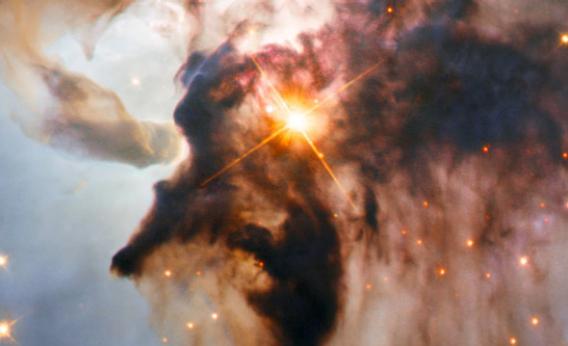Create a free profile to get unlimited access to exclusive videos, sweepstakes, and more!
The Depths of the Lagoon

The Lagoon Nebula is a vast, 100-light-year-wide star factory. It’s a huge cloud of gas and dust, and inside of it stars are born out of that material. It’s very active, and has been for a long time; embedded in it is a cluster of more than 1,000 stars that are only a few million years old. They formed from the gas in and near the nebula.
Star-forming nebulae are typically a mess, with massive stars blasting out radiation and fierce winds of subatomic particles. This slams into the material floating between the stars, lighting it up and sculpting it into fantastic and frankly weird shapes.
So when you point Hubble Space Telescope at the Lagoon, you see just what gorgeous chaos it is:
That is breathtaking. And a little unusual. Most images of the Lagoon are taken in visible light, to better trace the hydrogen in it, which glows red. While this Hubble image does use a red filter that picks out the hydrogen, it also employs a filter that only lets through infrared light.
That’s important because the Lagoon is lousy with dust, tiny grains of silicates (rock), and long, complex organic molecules that are essentially soot. In sufficient quantities, dust is opaque to visible light. However, IR light can get through, at least a bit better than the light our eyes can see. So in this image, were seeing through the thinner dust into the nebula itself.
The bright star is called Herschel 36, and is responsible for a lot of the radiation lighting up the gas around it. But as you can see, there’s a lot of dark stuff too: That’s dust, very thick patches of it. The gas and dust is moving, violently blown about by the light and winds from massive stars. Some of the gas is cooler and some hotter, and where they meet you get those long wispy tendrils draping down. It almost looks like a cosmic waterfall.
I’m also drawn to the weird tadpoles at the upper left; those are very dense knots of material that are resisting the erosive forces around them. You see these in many nebulae (like in the famous “Pillars of Creation”), and they’re where stars are being born. The material around them is particularly dense, so they can survive the fierce environment longer … usually. It’s not clear if these knots will be able to birth their stars before the ridiculously hostile surroundings dissolve them entirely.
One more thing: See how many stars appear red? Dust scatters incoming light, sending it off in all different directions. This is strongly color dependent; blue light is more heavily scattered than red (which is why the sky is blue; the Sun’s blue light comes at us from every direction, scattered by nitrogen molecules in the air). These stars look red because their blue light is flung away from our eyes by the dust, but the red light gets through. And in this image, what appears red is actually giving off a lot of infrared, so those stars really would look very red to your eye.
The Lagoon is one of my favorite summer targets when I take my telescope out; it’s bright enough to see easily in binoculars and shows quite a bit of detail in even modest telescopes. Now, when I view it, I’ll think of this image. It’ll give me an even greater appreciation for it than I already have.


























